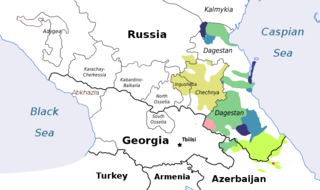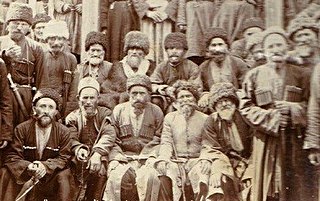Related Research Articles

The Nakh languages are a group of languages within the Northeast Caucasian family, spoken chiefly by the Chechens and Ingush in the North Caucasus.

The Golden Horde, self-designated as Ulug Ulus, was originally a Mongol and later Turkicized khanate established in the 13th century and originating as the northwestern sector of the Mongol Empire. With the division of the Mongol Empire after 1259, it became a functionally separate khanate. It is also known as the Kipchak Khanate or the Ulus of Jochi, and replaced the earlier, less organized Cuman–Kipchak confederation.
The Nart sagas are a series of tales originating from the North Caucasus. They form much of the basic mythology of the ethnic groups in the area, including Abazin, Abkhaz, Circassian, Ossetian, Karachay-Balkar, and to some extent Chechen-Ingush folklore.

A teip is a Chechen and Ingush tribal organization or clan, self-identified through descent from a common ancestor or geographic location. It is a sub-unit of the tukkhum and shahar. There are about 150 Chechen and 120 Ingush teips. Teips played an important role in the socioeconomic life of the Chechen and Ingush peoples before and during the Middle Ages, and continue to be an important cultural part to this day.
The history of Chechnya may refer to the history of the Chechens, of their land Chechnya, or of the land of Ichkeria.

Circassia, also known as Zichia, was a country and a historical region in Eastern Europe. It spanned the western coastal portions of the North Caucasus, along the northeastern shore of the Black Sea. Circassia was conquered by the Russian Empire during the Russo-Circassian War (1763–1864), after which approximately 99.5-99.8% of the Circassian people were either exiled or massacred in the Circassian genocide.

The Chechens, historically also known as Kisti and Durdzuks, are a Northeast Caucasian ethnic group of the Nakh peoples native to the North Caucasus. They are the largest ethnic group in the region and refer to themselves as Nokhchiy. The vast majority of Chechens are Muslims and live in Chechnya, an autonomous republic within the Russian Federation.

Giyasuddin Muhammad Uzbek Khan, better known as Özbeg (1282–1341), was the longest-reigning khan of the Golden Horde (1313–1341), under whose rule the state reached its zenith. He was succeeded by his son Tini Beg. He was the son of Toghrilcha and grandson of Mengu-Timur, who had been khan of the Golden Horde from 1266 to 1280.

A burka is a coat made from felt or karakul.

The Nakh peoples are a group of North Caucasian peoples identified by their use of the Nakh languages and other cultural similarities. These are chiefly the ethnic Chechen, Ingush and Bats peoples of the North Caucasus, including closely related minor or historical groups.

The deportation of the Chechens and Ingush, or Ardakhar Genocide, and also known as Operation Lentil, was the Soviet forced transfer of the whole of the Vainakh populations of the North Caucasus to Central Asia on 23 February 1944, during World War II. The expulsion was ordered by NKVD chief Lavrentiy Beria after approval by Soviet leader Joseph Stalin and Anastas Mikoyan, as a part of a Soviet forced settlement program and population transfer that affected several million members of ethnic minorities in the Soviet Union between the 1930s and the 1950s.
The Vainakh peoples of the North Caucasus were Islamised comparatively late, during the early modern period, and Amjad Jaimoukha (2005) proposes to reconstruct some of the elements of their pre-Islamic religion and mythology, including traces of ancestor worship and funerary cults. The Nakh peoples, like many other peoples of the North Caucasus such as Circassians, practised tree worship, and believed that trees were the abodes of spirits. Vainakh peoples developed many rituals to serve particular kinds of trees. The pear tree held a special place in the faith of Vainakhs.
Amjad M. Jaimoukha was a Jordanian Circassian writer, publicist, and historian, who wrote several books on North Caucasian – specifically Circassian and Chechen – culture and folklore.
Circassian music refers to the traditional songs and instruments of the Circassians.
During the 13th and 14th centuries, the Mongols launched two long, massive invasions of the territory of modern Chechnya and Ingushetia, which included the lands of Alania in the west, Simsir in the northeast, and the Georgian-allied polity of Durdzuketia in the south. They caused massive destruction and human death for the Durdzuks, but also greatly shaped the people they became afterward. However, this came at great cost to them, and the states they had built were utterly destroyed, as were their previous organized systems. These invasions are among the most significant occurrences in Chechen and Ingush history, and have had long-ranging effects on Chechnya, Ingushetia and their peoples.
Chechnya was first incorporated as a whole into the Russian Empire in 1859 after the decades-long Caucasian War. Tsarist rule was marked by a transition into modern times, including the formation of a Chechen bourgeoisie, the emergence of social movements, reorientation of the Chechen economy towards oil, heavy ethnic discrimination at the expense of Chechens and others in favor of Russians and Kuban Cossacks, and a religious transition among the Chechens towards the Qadiri tariqa of Sufism.

Simsim was either a historical region or kingdom in the North Caucasus during the Middle Ages, existing in the 14th century. Predominantly localized roughly in eastern Chechnya (Ichkeria), with some also connecting part of Kumyk Plain. Simsim is also localized in both Chechnya and Ingushetia. Its name may have been derived from the Chechen village of Simsir. However, according to folklore, the King Gayur-khan was chosen as the leader of all Chechens by the Mehk-Khel. In its later years it allied itself with the Golden Horde before being destroyed in 1395 by Timurlane, which was recorded in Zafarnama by Nizam al-Din Shami and the Zafarnama by Sharaf ad-Din Ali Yazdi.
Gayur-khan or Kyr Bek was the king of Simsir in the 14th century. He was involved in the Timurid invasion of the Caucasus and was recorded in the two Persian chronicles: Zafarnama by Nizam al-Din Shami and the Zafarnama by Sharaf ad-Din Ali Yazdi.

The Mongol invasion of Circassia and Alania refers to the invasion of Circassia and Alania by the Mongolian Empire. During the 13th and 14th centuries, the Mongols launched massive invasions of the territory of Circassia and Alania. William of Rubruck, who travelled to the Caucasus in 1253, wrote that the Circassians had never "bowed to Mongol rule", despite the fact that a whole fifth of the Mongol armies were at that time devoted to the task of crushing the Alano-Circassian resistance. Circassians and Alans made use of both the forests and the mountains, and waged a successful guerrilla war, maintaining their freedom to some extent.

A referendum on creating the Republic of Ingushetia within Russian Federation was held in Ingushetia on 30 November 1991.